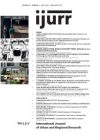Urban scholars lament the loss of public space due to heightened security and behavioral controls borne of economic priorities and anti‐terror concerns after September 11th 2001. Owners and managers of government buildings, banks and courthouses have closed streets and fitted the surrounding space with concrete barriers, bollards and moat‐like structures to prevent potential terror attacks. These are reasonable protections in emergency situations, but, as threat levels fall, these zones fail to incorporate a diversity of users, privatizing the space for those with security clearance. The ubiquity of these zones encourages us to consider them as a new type of land use. To test this statement, we describe the results of site visits to two high‐profile New York City neighborhoods (one with numerous civic buildings, the other populated with corporate headquarters). Using a simple tool we developed, we find that 27% of aggregate non‐building area in the two districts is now in a security zone. Interestingly, the percentage of space within each district that can be classed as a security zone is reasonably similar, providing insight into the way in which terror targets are internally and externally defined and justified. We argue that this new type of land use is an important and permanent feature of twenty‐first century global cities.
Details
Written by:
JEREMY NÉMETH, JUSTIN HOLLANDER
Digital Object Identifier (DOI)
10.1111/j.1468-2427.2009.00899.x
About DOI
Read full article as PDF
Read full article as HTML
See the references for this article
